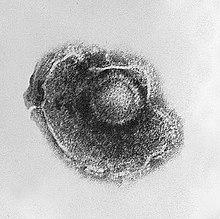
Back Varicella Zoster ACE فيروس جدري الماء النطاقي Arabic بوشويكة-زونا ARY فيروس جدرى الماء النطاقى ARZ Virus de la varicel·la zòster Catalan ڤایروسی ڤاریسێللا زۆستێر CKB Varicella zoster virus Czech Varizella-Zoster-Virus German Virus varicela-zóster Spanish Barizela-zoster birus EU
| Human alphaherpesvirus 3 | |
|---|---|

| |
| Electron micrograph of a Human alphaherpesvirus 3 virion | |
| Virus classification | |
| (unranked): | Virus |
| Realm: | Duplodnaviria |
| Kingdom: | Heunggongvirae |
| Phylum: | Peploviricota |
| Class: | Herviviricetes |
| Order: | Herpesvirales |
| Family: | Orthoherpesviridae |
| Genus: | Varicellovirus |
| Species: | Human alphaherpesvirus 3
|
| Synonyms | |
Varicella zoster virus (VZV), also known as human herpesvirus 3 (HHV-3, HHV3) or Human alphaherpesvirus 3 (taxonomically), is one of nine known herpes viruses that can infect humans. It causes chickenpox (varicella) commonly affecting children and young adults, and shingles (herpes zoster) in adults but rarely in children. As a late complication of VZV infection, Ramsay Hunt syndrome type 2 may develop in rare cases. VZV infections are species-specific to humans. The virus can survive in external environments for a few hours.[3]
VZV multiplies in the tonsils, and causes a wide variety of symptoms. Similar to the herpes simplex viruses, after primary infection with VZV (chickenpox), the virus lies dormant in neurons, including the cranial nerve ganglia, dorsal root ganglia, and autonomic ganglia. Many years after the person has recovered from initial chickenpox infection, VZV can reactivate to cause shingles.[4]
- ^ "ICTV 9th Report (2011) Herpesviridae". International Committee on Taxonomy of Viruses (ICTV). Archived from the original on December 22, 2018. Retrieved 9 January 2019.
Human herpesvirus 3 Human herpesvirus 3 [X04370=NC_001348] (HHV-3) (Varicella-zoster virus)
- ^ "ICTV Taxonomy history: Human alphaherpesvirus 3". International Committee on Taxonomy of Viruses (ICTV). Retrieved 9 January 2019.
- ^ "Pathogen Safety Data Sheets: Infectious Substances – Varicella-zoster virus". canada.ca. Pathogen Regulation Directorate, Public Health Agency of Canada. 2012-04-30. Retrieved 2017-10-10.
- ^ Nagel MA, Gilden DH (July 2007). "The protean neurologic manifestations of varicella-zoster virus infection". Cleveland Clinic Journal of Medicine. 74 (7): 489–94, 496, 498–9 passim. doi:10.3949/ccjm.74.7.489. PMID 17682626.